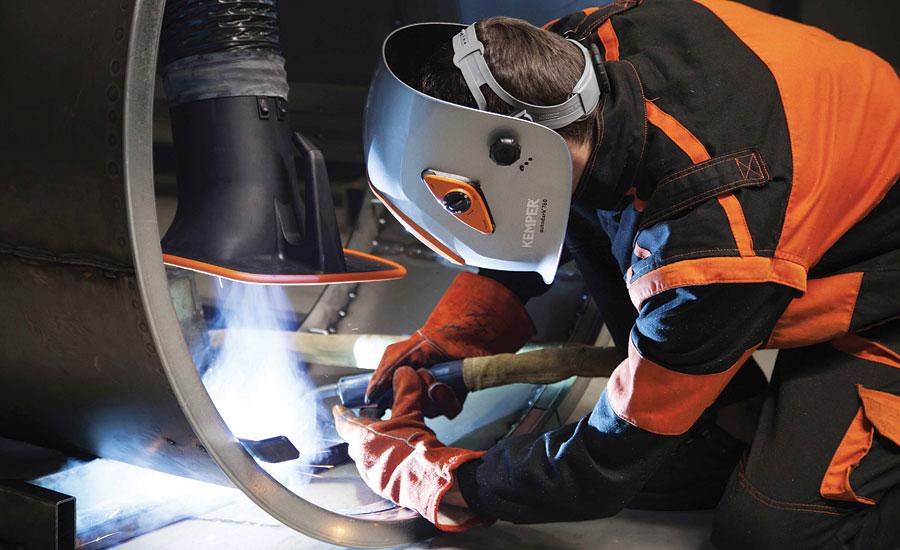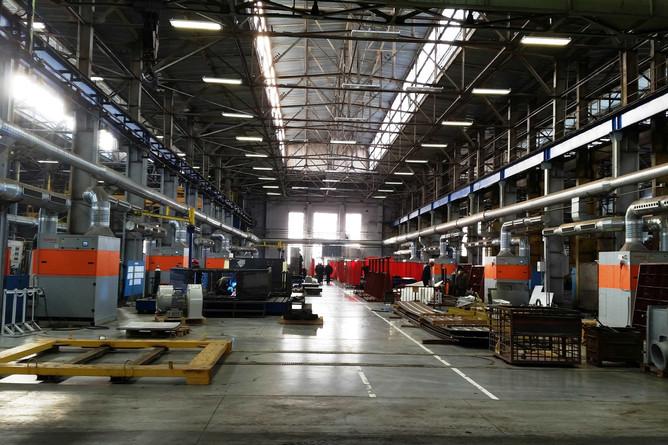President
- FMA
- The Fabricator
- FABTECH
- Canadian Metalworking
Categories
- Additive Manufacturing
- Aluminum Welding
- Arc Welding
- Assembly and Joining
- Automation and Robotics
- Bending and Forming
- Consumables
- Cutting and Weld Prep
- Electric Vehicles
- En Español
- Finishing
- Hydroforming
- Laser Cutting
- Laser Welding
- Machining
- Manufacturing Software
- Materials Handling
- Metals/Materials
- Oxyfuel Cutting
- Plasma Cutting
- Power Tools
- Punching and Other Holemaking
- Roll Forming
- Safety
- Sawing
- Shearing
- Shop Management
- Testing and Measuring
- Tube and Pipe Fabrication
- Tube and Pipe Production
- Waterjet Cutting
Industry Directory
Webcasts
Podcasts
FAB 40
Advertise
Subscribe
Account Login
Search
The importance of meeting OSHA standards for ventilation
Improve the air and your bottom line
- By Benjamin Howell
- June 7, 2018
- Article
- Safety
From slippery floors to noise, numerous hazards exist in every workplace. But one of the very worst hazards is polluted air, particularly in the welding environment.
Regardless of the industry concerned, the Occupational Safety and Health Administration (OSHA) recommends that hazards of all kinds be controlled at the source. In some industries, it is possible to build an engineered barrier between the hazard and the workspace. Additionally, specific personal protective equipment (PPE) should be worn or used to minimize any type of risk.
In the welding industry, common PPE includes safety goggles, welding helmets fitted with filter glass, gauntlets, spats, aprons, and heat-resistant gloves. Work areas also should be screened off so that others in the work area are not exposed to the electric arc or its reflection while welding is being conducted. The intense light associated with the arc can cause permanent eye damage.
The dangerous health risks of breathing in welding fumes are horrendous. In addition to relatively minor symptoms like dizziness; nausea; and nose, throat, and eye irritations, OSHA warns that prolonged exposure to welding fumes and gases over time can result in lung damage and various forms of cancer. Welding fumes also can cause stomach ulcers, damage to the nervous system, kidney damage, and conditions like metal fume fever.
Welding in confined spaces is particularly risky and can lead to asphyxiation and suffocation.
If the OSHA standards are met or, better yet, exceeded, welders and other employees working in potentially hazardous environments will have clean, unpolluted air to breathe.
OSHA Standards for Ventilation
It is essential that all welders understand the hazards they are exposed to. It is even more important that employers take steps to minimize these hazards.
While general ventilation that ensures natural or even forced movement of fresh air in the welding environment reduces gas and fume levels, this is not adequate. Not even welding outdoors or in open spaces provides sufficient ventilation for welders. Rather, local exhaust ventilation systems should be employed at the source to ensure that fumes, welding dust, and harmful gases are removed from every worker’s breathing zone.
Flexible or portable exhaust systems should be positioned to remove the polluted air away from the welder’s breathing zone.
Alternatively, general mechanical ventilation can ensure that welding fumes and polluted air are minimized and maintained within safe limits that meet OSHA’s health and safety regulations.
If necessary, additional respiratory protection may be needed, particularly if adequate ventilation cannot be provided.
But these are minimum specifications; ideally, a proven general mechanical system should be used together with a local exhaust system.
Industry Options for Improving Ventilation in Welding Environments
While the ventilation equipment chosen must meet the needs of the type of welding carried out as well as the location used, the best system ensures that the entire workshop, factory floor, or industrial warehouse is properly ventilated.
General Mechanical Ventilation Systems
Welding operations pollute the air. The warm, contaminated air rises and then sinks when it cools. Traditional push/pull, duct-type ventilation systems literally pull the polluted air out of the workshop via pipes and push clean air back, also via pipes (Figure 1). This type of system works reasonably well if smoke and dust levels are low, but it has obvious shortcomings, including the fact that it relies on a circular flow of air, and inevitably some dust and fumes mix in with the air that has been purified.
A recent development is a freestanding air tower that uses principles of displacement flow to provide the best possible full-room ventilation. It works in a similar but much more sophisticated way than the traditional push/pull system. Remember that warm, polluted air rises, and the tower sucks this contaminated air in from the top through its 360-degree lamella or gills. A two-stage method automatically cleans the filter. Because the air is pushed out slowly, without any turbulence, the possibility of dust and fumes polluting this clean air is reduced. Additionally, dust that is not contaminated is collected into bins for easy disposal.
Freestanding air towers are suitable for all types of welding applications, and they work exceptionally well in large production areas and where local exhaust systems aren’t possible.
Local Exhaust Ventilation Systems
Local exhaust ventilation systems use a variety of welding fume exhausts as well as filtration units, many of which are mobile. Wall-mounted or large central units can be attached to highly efficient exhaust arms that filter the polluted air at the source.
The choice of a local exhaust system depends on a number of requirements. For instance, some are more suitable for frequent or continuous use than others, while some are better-suited for use at workstations that change frequently.
Features also vary. For instance, you might prefer a mobile filter that has an exhaust hood that rotates and swivels and doesn’t have to be adjusted frequently. Maybe an automated cleaning cycle is important to you, or you just want a self-cleaning filter incorporated in a unit that has automatic dust disposal. Some units are meant for welding environments where there isn’t much dust or smoke; others are designed to handle high levels of dust and smoke.
Central and freestanding filtration units also vary, although all are stationary. A central extraction unit designed for use with robots is a good choice for large welding workshops or where grinding is common. It has a filter that is cleaned automatically with rotating nozzles and compressed air and can be used with various exhaust arms if required.Another type, designed for use in smaller workshops, can be used at up to four workstations at one time and be connected to a central piping system.
All of these systems are OSHA-compliant.
It really is a no-brainer that those operating welding workshops and factories should use well-designed ventilation equipment to keep their employees (and themselves) safe and healthy. Ultimately, doing so helps ensure that workers perform better, which improves productivity, reduces costs, and increases profits.
About the Author
Benjamin Howell
1110 Ridgeland Pkwy, Suite 110
Alpharetta, GA 30004
770-416-7070
Related Companies
subscribe now

The Fabricator is North America's leading magazine for the metal forming and fabricating industry. The magazine delivers the news, technical articles, and case histories that enable fabricators to do their jobs more efficiently. The Fabricator has served the industry since 1970.
start your free subscription- Stay connected from anywhere

Easily access valuable industry resources now with full access to the digital edition of The Fabricator.

Easily access valuable industry resources now with full access to the digital edition of The Welder.

Easily access valuable industry resources now with full access to the digital edition of The Tube and Pipe Journal.
- Podcasting
- Podcast:
- The Fabricator Podcast
- Published:
- 04/16/2024
- Running Time:
- 63:29
In this episode of The Fabricator Podcast, Caleb Chamberlain, co-founder and CEO of OSH Cut, discusses his company’s...
- Trending Articles
Tips for creating sheet metal tubes with perforations

Supporting the metal fabricating industry through FMA

JM Steel triples capacity for solar energy projects at Pennsylvania facility

Fabricating favorite childhood memories

Omco Solar opens second Alabama manufacturing facility

- Industry Events
16th Annual Safety Conference
- April 30 - May 1, 2024
- Elgin,
Pipe and Tube Conference
- May 21 - 22, 2024
- Omaha, NE
World-Class Roll Forming Workshop
- June 5 - 6, 2024
- Louisville, KY
Advanced Laser Application Workshop
- June 25 - 27, 2024
- Novi, MI




























